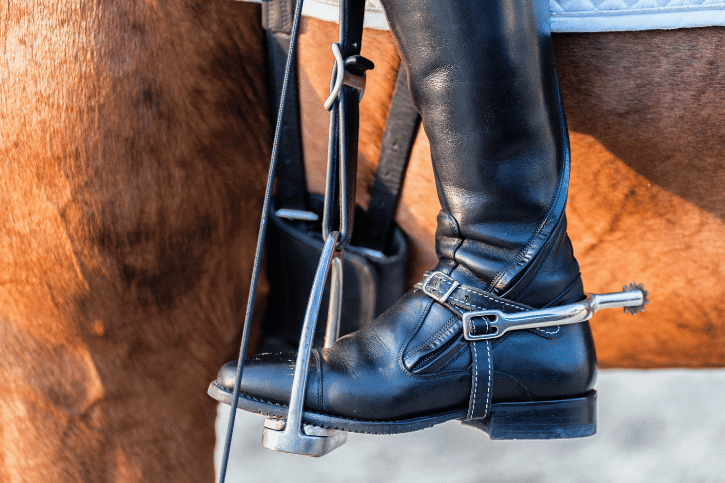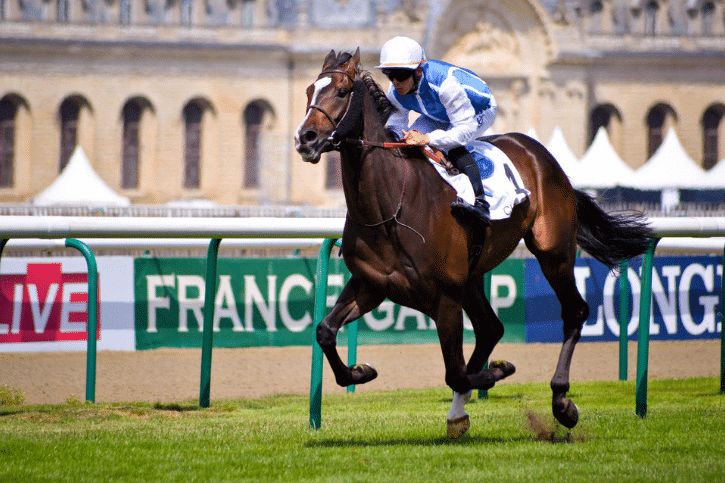Do Jockeys Wear Spurs?
I’ve been on a kick lately where I’ve been watching a whole lot of old Western movies.
Something about those 10-gallon hats, leather gun holsters, and shiny metal spurs just gets me.
What can I say? They make me happy.
There is a particular scene that has stuck with me for the last couple of weeks.
The movie outlaw is running from the Sheriff and his posse on horseback.
His horse isn’t going fast enough, so the outlaw repeatedly and cruelly kicks the horse with his spurs.
I have to admit it looked far too realistic for my comfort (That poor horse!), but it gave me an idea.
I thought I could learn about spurs and their different uses in horseback riding, and then report back to you all.
The first question I looked into was suggested by my mother-in-law: do racehorse jockeys wear spurs?
The answer to this question is no, jockeys do not usually wear spurs. Because of the way jockeys ride, there isn’t really a way for them to properly use spurs. Jockeys usually use whips as a riding aid instead. Spurs are used more commonly for horse riding activities like dressage, where riders need precise control of their horse’s movements.
As you read on, we will discuss when spur use is appropriate and when it isn’t, what regulations are placed on the use of spurs in competitions, what spurs actually do, and what types of spurs are available for riders.
What are spurs?

Spurs are made of metal and attached to the heel of your riding boot.
They help reinforce your aids (such as your legs, arms, and seat), they help the rider evoke a quicker reaction to your leg aids, spurs can be used for helping refine more precise, delicate movements of your horse, and they can also be used for horses that find the pressure of your leg aid to be too much.
Spurs are never to be used to punish your horse.
What are the main types of spurs?
Round end spurs (ball on the shank)
Knob end spurs (squared off with blunt edge)
Roller spurs: disc (rolling disc with no teeth), ball (plastic roller-very subtle)
Teethed: blunt wheel with teeth, at least 8 required, and is gentler the more teeth
Prince of Wales spur (flat end that is a little sharper)
Swan neck spurs (shank goes up at an angle)
Waterford spurs (large metal ball at the end of the shank)
Le spur or Comb spurs (has small teeth inside heel band)
Half Mounted spurs are decorated on one side (the side facing outwards)
Full Mounted spurs are decorated on both sides
What types of horseback riders wear spurs?
Dressage riders, show jumpers, and other event riders, whether Western (Rodeo) or English, often wear spurs. Casual riders do not usually wear spurs.
What types of horseback riders should not wear spurs?
New riders should not wear spurs until they have built up a decent amount of muscle control in their legs.
If they cannot hold their legs in the correct position, they risk hurting the horse.
Spurs are a tool for greater preciseness, and you have to know the basics before you can start fine-tuning!
Do spurs make horses go faster?
In general, the answer is no, spurs do not make horses go faster.
Some individual horses will respond to the use of spurs by increasing speed, but it is not a universal response.
Spurs are to direct your horse’s precise movements and communicate with them, not to make them go faster.
Are spurs abusive to horses?
Any spurs that have sharp, pointy, or jagged edges that could stab or cut a horse should not be used in any circumstances.
Those are definitively abusive and cruel.
And, sadly, there are those people who use excessive force with their spurs, regardless of their bluntness, and can cause their horse bruises.
Training is needed to be able to properly use spurs without risking any injury to your horse.
Spurs are not for beginning riders.
Beyond that, you will find some argument about whether or not using spurs is ethical.
Some people think spurs are fine when they’re properly blunt and used by someone who knows what they’re doing, while other people do not think spurs should be used at all.
There are people who believe that spurs are necessary for the safety of both rider and horse.
Overall, though, consensus seems to be that spurs are ethical if used correctly.
What regulations are there on spur use in horse competitions?
Regulations vary for every style of riding and events within that stye.
As an example of the type of regulations you might find, here are some of the dressage requirements:
Spurs must be metal, English-style.
Hard plastic knobs on shank of metal spurs are okay.
Dummy spurs with no shank are okay.
There is a maximum allowed spur length, depending on the event.
Rowels (wheels) must be smooth or blunt and able to rotate.
Are spurs more humane than whips?
Blunt spurs, used properly to direct, are humane.
Padded riding crops, used properly as a safety tool, are humane.
It is not the objects themselves that are humane or inhumane, it’s the way they are used.
Although scientifically, it has been shown that hitting horses does not help them win races, jockeys are most likely to use their crop when they’re nearing the finish line, to try and give their horse a final “boost.”
In Australia, for instance, although they have a rule that you can only hit your horse five times during the race, this disappears in the last 100 meters, when you can hit them as much as you want.
This can be cruel, and the rider is effectively punishing their horse for doing what they want.
While jockeys do not generally use spurs, spurs are commonly used by riders in other competitive horse sports.
The type of spur varies with the type of riding you are doing. If utilized properly, spurs should not hurt your horse in any way.
